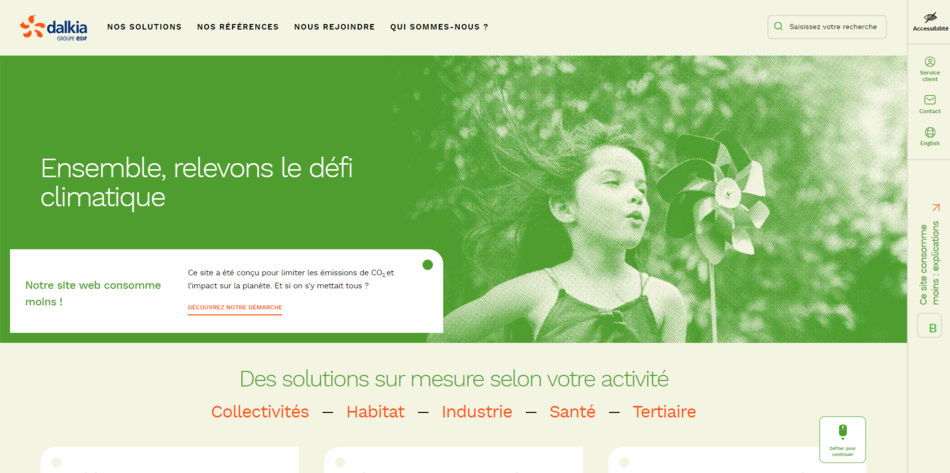The eco-design of websites offers the possibility of reducing the carbon footprint of companies while meeting the growing expectations of environmentally conscious customers. In this article, let's explore the ecological web in 2023 where the carbon footprint of the web already represents 4% of total emissions. In 2025 it should reach 8%.
Why choose an ecological website?
In June 2023, it is estimated that more than two billion sites internet have been identified by search engines. 252 websites are created every day according to Siteefy.
It is crucial to note that the sites accessible by these engines represent only a fraction, with many more present in the deep web and dark web. Each page viewed generates approximately 1,8 grams of carbon dioxide (CO2), a figure that can be multiplied by up to five depending on the design of the site.
Thus, the creation of an ecological website makes it possible in particular to:
- Reduce the carbon footprint: The web servers that host websites consume energy to operate and cool their equipment. By opting for eco-responsible design and hosting practices, we can reduce energy consumption and greenhouse gas emissions associated with web operations. This helps fight climate change.
- Save energy and resources: Poorly optimized sites can overload servers, requiring more computing and cooling power. By adopting efficient programming techniques and reducing the weight of web pages (images, scripts, etc.), we can reduce the energy consumption necessary for their loading. This helps conserve resources and reduce hosting costs.
- Promote awareness & social responsibility: By adopting eco-friendly web design practices, businesses send a positive message about their commitment to sustainability. This can generate interest among environmentally conscious consumers and strengthen the company's reputation. Additionally, it may encourage other actors to follow this path.
How to go about eco-designing a website?
Designing an eco-friendly website requires thoughtful choices. If we take the example of the site of the Musk Foundation, it is considered one of the least emitters of CO2 per visit, producing only 0,009 grams of carbon dioxide. While this extreme may not be necessary for all sites, user experience (UX) remains an essential consideration when creating eco-friendly sites.
Here are some guidelines for getting started in creating an eco-designed website:
- First of all, the choice ofweb host is a crucial first step. Some stand out for their ecological commitmentas an Ionos with his offer Green Hosting, using carbon-free electricity and/or recycling their obsolete equipment.
- It is then necessary to ensure the lightness of web pages. To do this, you must optimize the size of images, scripts and source code. Minimizing server requests and minimizing unnecessary elements helps reduce energy consumption when loading pages.
- Graphic design is also an interesting lever, particularly by favoring colors, fonts and minimalist visual elements. This can help reduce server workload and speed up page loading.
- Finally, the continuous monitoring and optimization are essential. Using analysis tools to assess site energy performance and identify areas for improvement is a recommended practice. The ultimate goal is to create a website that provides an optimal user experience while minimizing its impact on the environment.
Test your ecological performance
Testing the ecological performance of the site is really useful and can be done using tools such as Website Carbon, which calculates the carbon footprint per visit, and PageSpeed Insight from Google, which measures loading time.
A concrete example of an eco-designed site is that of Dalkia, which redesigned its site in 2021 by putting eco-design at the forefront. The result: a fast loading, sober design, and an significant reduction in the number of pages and files. The Dalkia site produces only 0.84g of CO2 per page visited, which places it in the category of the most environmentally friendly websites, thus surpassing 84% of sites.
To illustrate this data, consider the example of the image below. The original image was 1,30 MB, but after being resized 50%, it was only 366 KB. By converting this image to webp format, its size was further reduced to 217 KB (or 0,217 MB). In the end, the image only represents 20% of the initial weight, thus showing thepositive impact of these optimizations on the ecological performance of the site.
The benefit of eco-design in SEO
The interest in eco-design in SEO is today more crucial than ever. In fact, the environmental performance of a website have a direct impact on its ranking in search engines. Search engines, such as Google, consider user experience factors, including page loading speed and visual stability, to determine the quality of a site. Web core vitals have become major criteria for ranking websites. Among the main indicators, we find:
- TTFB (Time To First Byte): This is the time it takes for the first byte of the site to be loaded after exchanging requests with the server.
- FCP (First Contentful Paint): This is the moment when the first visual element, such as color or text, appears on the visited page.
- LCP (Largest Contentful Paint): It measures how long it takes to display the largest element on the page, usually poorly sized images, although it can also include videos or other large media.
- TBT (Total Blocking Time): This is the reaction time between the user's interaction on the site and the moment when the site can respond to this interaction.
- CLS (Cumulative Layout Shift): It evaluates the visual stability of the page. When elements are not properly fixed in the HTML structure or CSS, their position can change during page load, creating an unstable user experience.”
The interest in eco-design in SEO is today more crucial than ever. Indeed, the environmental performance of a website has a direct impact on its ranking in search engines. Search engines, such as Google, consider user experience factors, including page loading speed and visual stability, to determine the quality of a site. Web core vitals, such as Largest Contentful Paint (LCP) and Cumulative Layout Shift (CLS), have become major criteria for ranking websites. Thus, an eco-designed website, which minimizes its energy consumption and optimizes its performance, has a competitive advantage in terms of SEO. By integrating eco-design practices into the site development process, SEO professionals can improve their clients' online visibility while helping to reduce the web's carbon footprint. This is a double benefit which shows that eco-design is not only a responsible approach, but also a winning strategy for web referencing.
Conclusion
In summary, the eco-design of a website is entirely achievable by following a set of well-defined steps, from the selection of the host to the optimization of the pages. It is imperative to achieve a harmonious balance between “functionality” and “aesthetics” while being aware of the environmental impact. It is recommended to ask essential questions about the need to implement new features, taking into account their environmental footprint. By adopting an eco-responsible approach to website design, we can both contribute to the preservation of our environment and offer an exceptional user experience.
Esteban Irschfeld, SEO Consultant at UX-Republic



